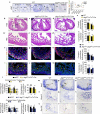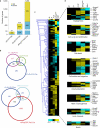Sequential Notch activation regulates ventricular chamber development
- PMID: 26641715
- PMCID: PMC4816493
- DOI: 10.1038/ncb3280
Sequential Notch activation regulates ventricular chamber development
Abstract
Ventricular chambers are essential for the rhythmic contraction and relaxation occurring in every heartbeat throughout life. Congenital abnormalities in ventricular chamber formation cause severe human heart defects. How the early trabecular meshwork of myocardial fibres forms and subsequently develops into mature chambers is poorly understood. We show that Notch signalling first connects chamber endocardium and myocardium to sustain trabeculation, and later coordinates ventricular patterning and compaction with coronary vessel development to generate the mature chamber, through a temporal sequence of ligand signalling determined by the glycosyltransferase manic fringe (MFng). Early endocardial expression of MFng promotes Dll4-Notch1 signalling, which induces trabeculation in the developing ventricle. Ventricular maturation and compaction require MFng and Dll4 downregulation in the endocardium, which allows myocardial Jag1 and Jag2 signalling to Notch1 in this tissue. Perturbation of this signalling equilibrium severely disrupts heart chamber formation. Our results open a new research avenue into the pathogenesis of cardiomyopathies.
Figures








Comment in
-
Heart disease modelling adds a Notch to its belt.Nat Cell Biol. 2016 Jan;18(1):3-5. doi: 10.1038/ncb3294. Nat Cell Biol. 2016. PMID: 26693916
References
-
- Sedmera D, Pexieder T, Vuillemin M, Thompson RP, Anderson RH. Developmental patterning of the myocardium. Anat. Rec. 2000;258:319–337. - PubMed
-
- Moorman AF, Christoffels VM. Cardiac chamber formation: development, genes, and evolution. Physiol. Rev. 2003;83:1223–1267. - PubMed
-
- Tevosian SG, et al. FOG-2, a cofactor for GATA transcription factors, is essential for heart morphogenesis and development of coronary vessels from epicardium. Cell. 2000;101:729–739. - PubMed
-
- Wessels A, Sedmera D. Developmental anatomy of the heart: a tale of mice and man. Physiol. Genomics. 2003;15:165–176. - PubMed
Publication types
MeSH terms
Substances
Grants and funding
LinkOut - more resources
Full Text Sources
Other Literature Sources
Molecular Biology Databases

